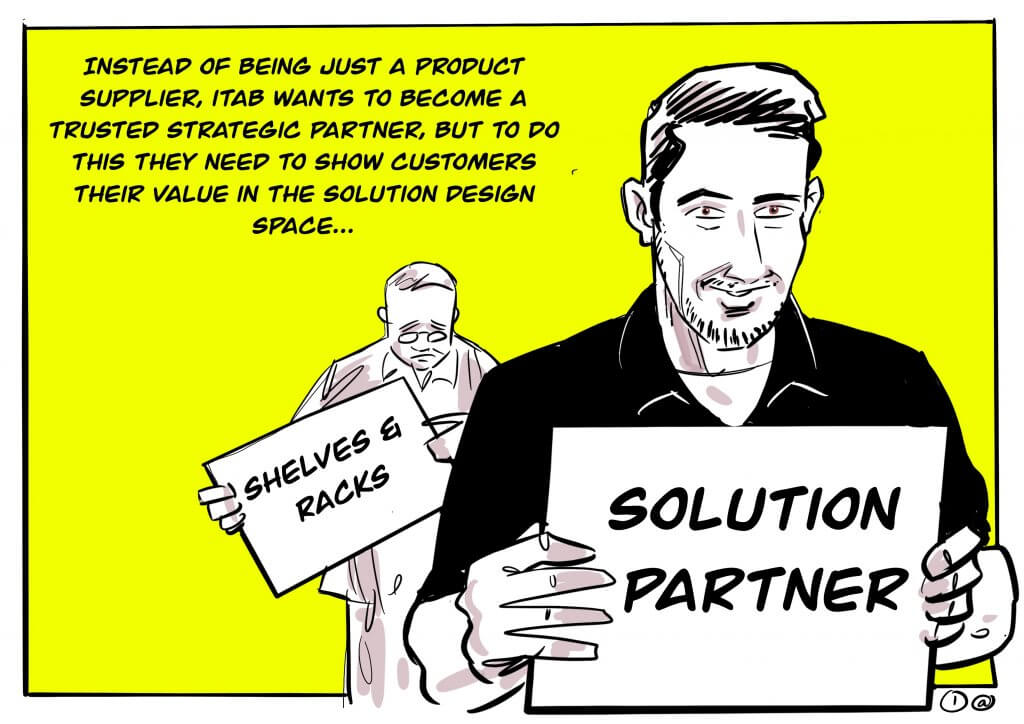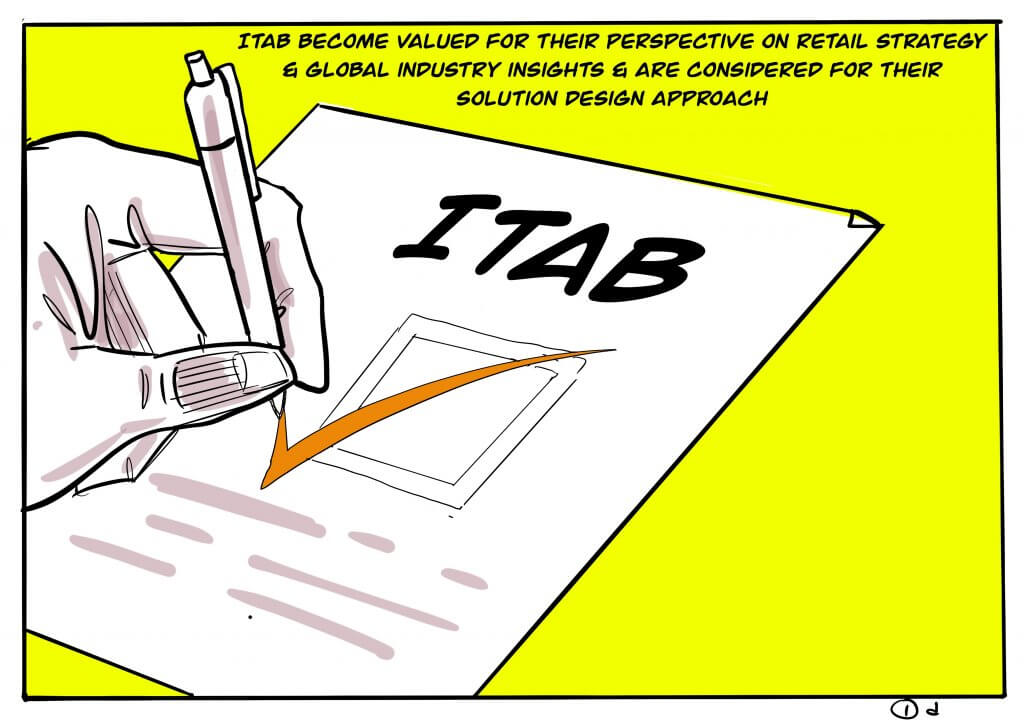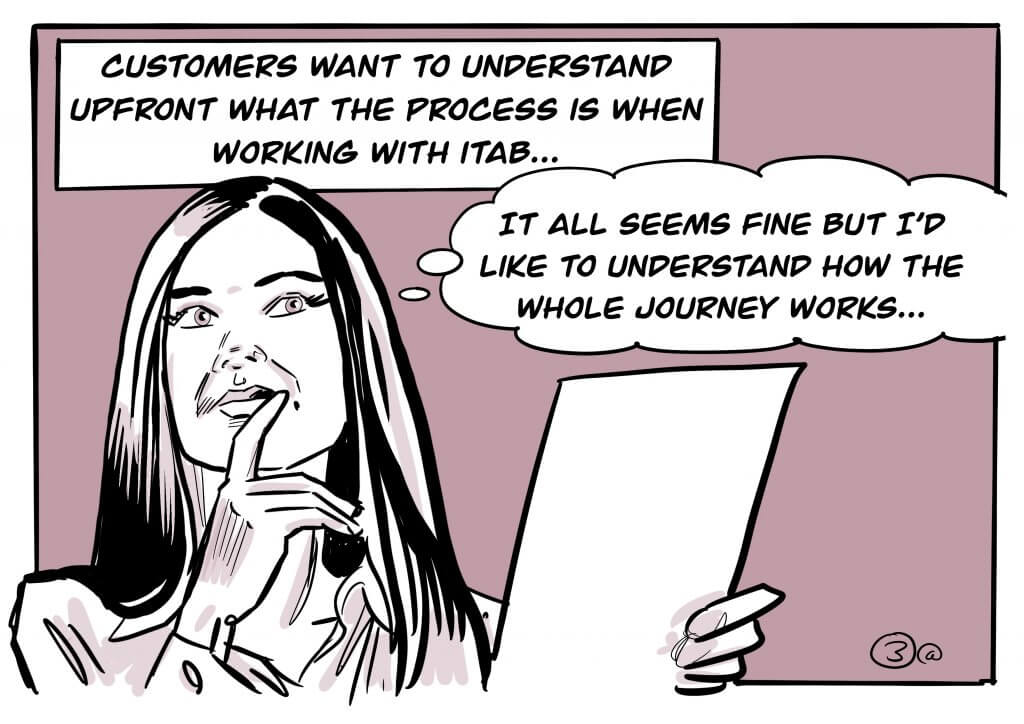ITAB: Creating greater value for customers with design thinking

How we can we help our teams truly understand the value of our offer and then bring that to life for customers?
ITAB is innovating in the way it serves its customers. It’s stepping beyond its core offer of working with retail customers to help co-create their in-store shopping experiences, and offering greater value through a range of additional services, including Solution Design.
ITAB help customers turn consumer brand experience into physical reality through its know-how, solutions and ecosystem of partners. Solution Design is ITAB’s own internal design thinking offer. They use a design thinking approach to provide their customers with fresh insights into what consumers want and need, so that together, they can develop compelling solutions that drive measurable results.
ITAB’s intention is to begin engagements with customers much earlier in the process, allowing them to guide their customers through an end-to-end process from conceptualisation to implementation and beyond.
To make the Solution Design approach as effective as possible, ITAB partnered with Treehouse Innovation to create a repeatable process and toolset that could be used to engage customers and build confidence in the team and wider organisation as they put it into practice.

Our role focused on co-creating a Solution Design blueprint and supporting guidance to help ITAB’s central team provide support to their colleagues around the world in understanding the value Solution Design can bring, how it works, and develop the skills they need to put it into practice.
Whilst Solution Design was already an established offer, it wasn’t yet being delivered outside of the UK, and there was a desire for greater consistency of approach, too.
We worked with a core team of eight people, with engagement from around 20 senior, cross-functional, cross-geography colleagues across a six month period 2021 and 2022.
What we did
- In-depth interviews with ITAB’s customers and employees to understand how the Solution Design offer could best serve them.
- Developed key insights on internal and external needs and opportunity areas.
- Mapped out every phase of the sales and customer engagement process, showing customer needs at each stage, as well as what happens internally at ITAB at each point.
- Used design thinking to define and explore the challenges ITAB and its customers faced at each stage of the customer journey.
- Led workshops with ITAB teams from all over the world to explore those challenges and generate ideas and prototypes for ways they could apply elements of Solution Design to help solve them.
- Used the concept of ‘scenography’ to envision ideal scenarios of how great customer engagements could look, based on insights gathered from ITAB colleagues. These were developed into reference illustrations that teams then used to inform and inspire real-life customer interactions, and shared feedback on their experiences.
- Put everything we learnt into the creation of a Solution Design blueprint, setting out every step ITAB teams can take with their customers to successfully implement the approach.
- Developed a branded toolkit, giving teams all the tools, frameworks and guidance they need to follow the blueprint effectively.

Chris Bright, Vice President, Solution Design
“When we had Andréas Elgaard join as our new CEO, it was all about moving the position of the business from traditionally being quite transactional, to becoming a solution provider. To make that happen, you’ve got to be more consultative, and use more of a design thinking approach to different challenges.
“We had some people using Solution Design already, but in pockets and across 22 countries. So, part of the challenge we tackled with Treehouse was: How do we get likeminded people from those pockets to come together and create an approach to using the Solution Design methodology, to support becoming that solution provider?
“We then went back a few steps to enable us to go forward. We spoke to our customers, to understand how they operate, and we spoke to consumers. It helped me understand that even in retail, you don’t know the answers, consumers know the answers because they set the trends. Their behaviour sets where you need to be as an organisation.
“It helped us understand what our customers expected. We then held the mirror up to ourselves to understand from their point of view, what do they see us doing? What would they like us to do?

“What surprised us most is that a proportion of our customers were really wanting [Solution Design] and said the offer will be compelling because it will create a one stop shop, and make their process slicker, a lot more efficient, and cost efficient. When we heard those words we realised we could move to becoming a partner for our customers.
“At the moment we have a buyer mentality where we help when a customer has a problem. But being a partner means we can work with them at the embryo point, and help mold what that brief could be, using our expertise and know-how. We’ve never actually been in that position before. So when our existing customers were telling us that we thought: a) they want it, b) they believe we could do it, and c) why didn’t we do this sooner?
“I really enjoyed working with Steve, Nathan and all of the Treehouse gang. What worked for us about working with an external consultant is that they take you a little bit outside your comfort zone, and show you that design is an iterative process, and that’s OK.
“We created an engagement model for how we engage our customers and what it looks like at each stage. People at ITAB rave about the tools, frameworks and materials created that they can pull upon and use in a workshop, interview or any other type of quantitative or qualitative research.
“By the end of working with Treehouse, we’d scaled it and we’ve had some great results. When Treehouse departed, it was my job then to say: How do we create this as a movement rather than just a way of working? How do we make it become part of our DNA?”
Steve Baker, Design Coach, Treehouse Innovation

“Our job was to help create clarity about what Solution Design is, why it’s powerful, and how to use it. I think our experience of helping organisations apply design thinking put us in a really good position to help ITAB think about how they apply Solution Design. It worked so well because the sponsorship team knew what they wanted, were enthusiastic, hardworking, keen, but also valued the opinions and the expertise that we brought.”
“I think the idea of co-design is a really important one. We really were working in partnership with the ITAB team. They were bringing ideas and content, and we would then agree our approaches, and design and build everything together. It was fantastic to see the ITAB team using what we had co-created, and that it had a material impact on the way they did business, because that’s ultimately why we do what we do.”
Brooke Kuhne, Facilitator and Consultant, Treehouse Innovation

“I think the blueprint ended up being a more creative approach than the team was expecting. Using the scenography process to create an example of how an engagement could go, and how they could add value to a customer, helped the team visualise a real engagement and then interpret it in their own way. I think it opened people’s eyes to new ways of having better relationships with customers.”
“The blueprint isn’t cast in stone – it doesn’t tell the team that they have to have a particular type of engagement with customers. But it does provide a set of design principles and key steps that will help them provide a good customer experience.”
Similar stories
SAP: Bringing leaders together to co-design a learning strategy
The Global Head of Learning for Sales at SAP asked the Treehouse Innovation team to help them develop innovative strategy for designing and delivering learning to the global SAP workforce.
Read moreMaximising project teams by building self-awareness
Find out how a leading consultancy specialising in innovation used the i2 Skills Assessment to pinpoint the strengths and weaknesses of their project teams.
Read moreThe innovation programme that inspired Sky Glass
How can we help a culture of innovation to spread? We’ve worked closely with the head of learning and development at Sky to build and rollout an innovation programme for all 600 Sky leaders. Every […]
Read more